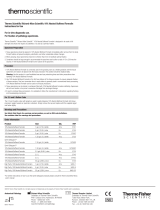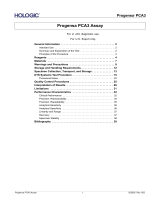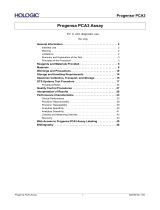Page is loading ...

PanPath B.V. - Tel.: +31 (0)495 499090 - info@panpath.nl - www.panpath.nl page 1 of 4
DATA SHEET-V8 CONTROL PROBES
Product Rembrandt® Biotin and Digoxigenin1 labelled DNA and RNA Control probes
Code QxxxP.xx00 (patents pending)
For research use only RUO
Technical specifications
Cat. No. Label
DNA Probe specifications
Description Size
Region
Q001P.0100
Q001P.9900
BIO
DIG
Negative control probe for DNA (CONTROL – BIO DISH)
Negative control probe for DNA (CONTROL – DIG DISH)
100-300 bp pSP; 3.0 Kb
Q151P.0100
Q151P.9900
BIO
DIG
Positive control probe for DNA (CONTROL + BIO DISH)
Positive control probe for DNA (CONTROL + DIG DISH)
30-mer oligonucleotide Mixture of six oligonucleotides
complimentary to ALU repeats
Q101P.0100
Q101P.9900
BIO
DIG
Negative control probe for RNA (CONTROL – BIO RISH)
Negative control probe for RNA (CONTROL – DIG RISH)
26-mer oligonucleotide 1 oligonucleotide
Q152P.0100
Q152P.9900
BIO
DIG
Positive control probe for RNA (CONTROL + BIO RISH)
Positive control probe for RNA (CONTROL + DIG RISH)
37-mer oligonucleotide 1 oligonucleotide complementary to
Poly-A
Contents : - clear vial, yello w cap = BIO labelled probe; 1 mL (10-100 assays)
- clear vial, purple cap = DIG labelled probe; 1 mL (10-100 assays)
Format : ready to use RTU
Applica tion : colorimetric detection of respective DNA and RNA in human specimen by in situ hybridisation (ISH)
Detection limit : 10-30 pg by filter hybridisa tion
Storage : refrigerated (2-8 °C); do not freeze
Stability : until expiry date printed on label
Precautions : - it is important to work RNase free in the period between deparaffinisation until after the h ybridisation; wear gloves
and incubate laboratory materials overnight at 200 °C before use
- homogenise solutions before use
-harmful: avoid contact with eyes and skin; do not swallow
RUO : research use only
Related products
Probes and detection kits/reagents
Please contact your local supplier for further information.
1 Digoxigenin (DIG) labeling and detec tion is protected by international patents of Roche M olecular Biochem icals. This pr oduct is supplied under a license of Roche M olecular Biochemicals. This
produc t or the use of this product may be covered by one or more patents of Roche M olecular B iochemicals, including the following: EP patent 0324 474 (granted); U.S. patent 5.354.657 (granted).

PanPath B.V. - Tel.: +31 (0)495 499090 - info@panpath.nl - www.panpath.nl page 2 of 4
Limitations of Procedure
Product Rembrandt® Biotin and Digoxigenin labelled DNA and RNA Control probes
• The REMBRANDT® DNA and RNA control probes are solely applicable for the detection of corresponding DNA and RNA which may be
present in cell preparations (paraffin sections, frozen sections or cytological specimen).
• Appropriate medical decisions are only possible if the medical traceability is ensured. The product is intended for professional use as an aid
in the diagnosis corresponding to the DNA and RNA probes as supplied.
• Either human tissue sections or human cytological preparations may be used. Samples must be fixed in buffered formalin or alcohol.
Sections should be cut at 4 um thickness, glued to the glass slides with a bio-adhesive (e.g. organosilane), dried at room temperature,
subsequently dried at 37 °C overnight, complete deparaffinisation in xylene and alcohol series and air dried. Cytological specimen should be
prepared as required by the user, fixed with cytological fixation agent, rinsed in distilled water prior to the ISH procedure and air dried.
• Many factors can influence the performance of the ISH procedure. Failure in detection can be due to i.e. improper sampling, handling, the
time lapse between tissue removal and fixation, the size of the tissue specimen in the fixation medium, the fixation time, processing fixed
tissue, the thickness of the section, the bio-adhesive on the slide, deparaffinisation procedure, incubation times, proteolytic pre-treatment,
detection reagents, incubation temperatures and interpretation of results.
• The performance of the ISH procedure is also affected by the sensitivity of the method and the DNA or RNA target load; in case the limit of
the sensitivity is reached or when the target DNA or RNA load is too low, a false negative reaction may be the result.
• The clinical interpretation of the results should not be established on the basis of a single test result. A precise diagnosis, in fact, should take
into consideration clinical history, symptoms, as well as morphological data. Negative results therefore do not rule out any possibility of a
positive specimen.
• The REMBRANDT® test results are not to be relied on in case the sampling, sampling method, quality, sample preparation, reagents used,
controls and procedure followed is not optimal.
• Therapeutic considerations based on the result of this test alone should not been taken. Positive results should be verified by other
traditional diagnostic methods such as but not limited to clinical history, symptoms, as well as morphological data.
• The medical profession should be aware of risks and factors influencing the intensity, the absence or presence of probe signals which can
not be foreseen when applying this test.
• The user should carefully consider the risk and use of sample material for this test in case the sample material does not contain sufficient or
representative test material.
• Laboratory personnel performing the test should be knowledgeable and be able to interpret the test results.
Interpretation of the results
First, check the negative and positive controls that have been incubated with the test slides simultaneously:
- The negative control should be really negative, i.e. not show any localised colour precipitations. If the negative control could be interpreted as
being positive, discard the results since no conclusions can be drawn.
- The positive control should show colour precipitations in conformity with the localisation of the target DNA or RNA. The colour should show the
proper shade and must be clearly visible in the preferential cell/ tissue type and correspond to the target localisation.
In the test slides, start under low power magnification and focus on localisation and colour to see whether:
- The positivity (colour precipitation) observed is localised in the cell type preferred by the target.
- The colour has the right shade (no endogenous or formalin pigment).
Use high power magnification to see whether:
- The positive staining texture (granular, etc), demarcation and localisation are conform the positive control staining pattern.
Product in combination with other devices
The REMBRANDT® DNA (DISH) and RNA (RISH) control probes are intended for stand-alone usage and is intended to be used in combination with
standard formalin fixed, paraffin embedded tissue blocks, standard tissue freezing, tissue sectioning (microtome), standard cytological preparation
methods, hot plate(s), stove(s), incubation device(s), water bath(s), temperature and incubation time control(s), proteolytic-, detection- and other
reagents (not supplied with this reagent) and a microscope. The combination has been tested and validated. Since the standard formalin fixed,
paraffin embedded tissue blocks, standard tissue freezing, tissue sectioning (microtome), standard cytological preparation methods, hot plate(s),
stove(s), incubation device(s), water bath(s), temperature controls, incubation time control(s) and other not supplied reagents such as but not limited
to proteolytic reagents, detection reagents and a microscope is not combined with the device as a product, conformity with the essential
requirements is not applicable. Assay validation criteria are mentioned in ‘Interpretation of the Results’ and are also depending on the target load,
which may influence the validation criteria.
Specifications of the RISH/DISH control probes:
Positive control DNA Negative control DNA Positive Control RNA Negative Control RNA
Specificity 100% 100% 100% 100%
Sensitivity 95% 95% 95% 95%

PanPath B.V. - Tel.: +31 (0)495 499090 - info@panpath.nl - www.panpath.nl page 3 of 4
References
1. Autillo-Touati A. et al., HPV Typing by In Situ Hybridization on Cervical Cytologic Smears with ASCUS, Acta Cytologica, Vol. 42, p.
631-638, 1998.
2. Benkemoun A. et al., Evaluation of KREATECH In Situ Hybridization Kits for Detection of Human Papillomavirus DNA on Cervical
Smears with “ASCUS”, 3rd International Symposium “Impact of Cancer Biotechnology Diagnostic & Prognostic Indicators”, Nice,
France, October 1996. Accepted for publication in Cancer Detection and Prevention.
3. Botma H.J. et al., Differential In Situ Hybridization for Herpes Simplex Virus Typing in Routine Skin Biopsies, Journal of Virological
Methods, Vol. 53, p. 37-45, 1995
4. Cooper K. et al., Human Papillomavirus DNA in Oesophageal Carcinomas in South Africa, Journal of Pathology, Vol. 175, p. 273-277,
1995.
5. Davidson B. et al., Angiogenesis in Uterine Cervical Intraepithelial Neoplasia and Squamous Cell Carcinoma: An
Immunohistochemical Study, International Journal of Gynecological Pathology, Vol. 16, p. 335-338, 1997.
6. Davidson B. et al., CD44 Expression in Uterine Cervical Intraepithelial Neoplasia and Squamous Cell Carcinoma: An
Immunohistochemical Study, European Journal of Gyneacology and Oncology, Vol. XIX, no. 1, p. 46-49, 1998.
7. Davidson B. et al., Inflammatory Response in Cervical Intraepithelial Neoplasia and Squamous Cell Carcinoma of the Uterine Cervix,
Pathology Research and Practice, Vol. 193, p. 491-495, 1997.
8. Gómez F. et al., Diagnosis of Genital Infection Caused by Human Papillomavirus Using In Situ Hybridization: The Importance of the
Size of the Biopsy Specimen, Journal of Clinical Pathology, Vol. 48, p. 57-58, 1995.
9. Jing X. et al., Detection of Epstein-Barr Virus DNA in Gastric Carcinoma with Lymphoid Stroma, Viral Immunology, Vol. 10, No. 1, p.
49-58, 1997.
10. Sugawara I. et al., Detection of a Helicobacter Pylori Gene Marker in Gastric Biopsy Samples by Non-Radioactive In Situ
Hybridization, Acta Histochemica et Cytochemica, Vol. 28, No. 3, p. 263-267, 1995.
11. Van den Brink W. et al., Combined ß-Galactosidase and Immunogold/Silver Staining for Immunohistochemistry and DNA In Situ
Hybridization, Journal of Histochemistry and Cytochemistry, Vol. 38, p. 325-329, 1990.
12. Yanai H. et al., Epstein-Barr Virus Infection in Non-Carcinomatous Gastric Epithelium, Journal of Pathology, Vol. 183, p. 293-298,
1997.
13. Yonezawa S. et al., MUC2 Gene Expression is Found in Non-invasive Tumors But Not in Invasive Tumors of the Pancreas and Liver:
Its Close Relationship with Prognosis of the Patients, Human Pathology, Vol. 28, No. 3, p. 344-352, 1997.
14. Ziol M. et al., Virological and Biological Characteristics of Cervical Intraepithelial Neoplasia grade I with marked koilocytic Atypia,
Human pathology, Vol 29, No. 10, p. 1068-1073, 1998.
15. Evans M. et al, Biotinyl-Tyramide-Based In Situ Hybridization Signal Patterns Distinguish Human Paplliloma Virus Type and Grade of
Cervical Intraepithelial Neoplasia, Mod Pathol 2002; 15(12):1339-1347
16. Hopman A. et al., Transition of high grade cervical intraepithelial neoplasia to micro-invasive carcinoma is characterized by integration
of HPV 16/18 and numerical chromosome abnormalities, J Pathol 2004; 202:23-33
17. Hopman A. et al., Human papillomavirus integration: detection by in situ hybridization and potential clinical application, J Pathol 2004;
202:1-4
18. Hafkamp et al., A subset of head and neck squamous cell carcinomas exhibits integration of HPV 16/18 DNA and overexpression of
p16INK4 A and p53 in the absence of mutations in p53 exons 5-8, Int. J. Cancer; 107(3):394-400
REFERENCE GUIDE
DIS H/RISH CONTROL PROBES
PRETREATMENT OF PARAFFIN SECTIONS
PROTEOLYTIC TREATMENT
HYBRIDIZATION PROCEDURE
1. Apply 1 drop or 20 µl of probe solution per specimen; cover with
coverslip
2. Hybridize 2-16 hrs 37°C incubator
3. Remove coverslips by soaking slides
in TBS buffer
4. Wash all slides in TBS buffer
Continue with:
DETECTION AND STAINING PROCEDURE
VIAL-
PROBE
LABEL
……………
ANLEITUNG
DIS H/RISH CONTROL PROBES
HERSTELLUNG VON PARAFFINSCHNITTEN
PROTEOLYTISCHE BEHANDLUNG
HYBRIDISIERUNGSPROZEDUR
1. Tropfen oder 20 µl der Sonde auf jedes Präparat geben und mit
einem Deckglas abdecken
2. Hybridisieren 2-16 Stunden bei 37°C Ofen
3. Entfernen der Deckgläser durch
Eintauchen in TBS Puffer
4. Präparate in TBS Puffer spülen
Verfolge mit:
DETEKTIONS- UND FÄRBEPROZEDUR

PanPath B.V. - Tel.: +31 (0)495 499090 - info@panpath.nl - www.panpath.nl page 4 of 4
GUIDE RÉFÉRENCE
DIS H/RISH CONTROL PROBES
PRE-TRAITEMENT DES SECTIONS PARAFFINEES
TRAITEMENT PROTEOLYTIQUE
PROTOCOLE D’HYBRIDATION
1. Ajoutez une goutte ou 20 µl d’une solution de sonde par
échantillon et couvrez avec une lamelle
2. Hybridez 2-16 hrs 37°C incubateur
3. Diffusez verticalement le tampon TBS
sur les lamelles
4. Rincez toutes les lames avec le tampon TBS
Continuer avec:
PROTOCOLE DE DETECTION ET DE COLORATION
VIAL-
PROBE
LABEL
……………
GUIA DE REFERENCIA
DIS H/RISH CONTROL PROBES
PRETRATAM IENTO DE LOS CORTES DE PARAFINA
TRATTAMIENTO PROTEOLITICO
PROTOCOLO DE HIBRIDACION
1. Añadir 1 gota o 20 µl de la solución de la sonda por muestra.
Cubrir con un cubre.
2. Hibridizar 2-16 horas a 37ºC en un incubador
3. Retirar los cubres sumergiendo los
portas en tampón TBS
4. Lavar todos los portas en tampón TBS
Continuar con:
PROTOCOLO DE DETECCION Y TINCION
HANDLEIDING
DIS H/RISH CONTROL PROBES
SNUJDEN EN PLAKKEN VAN PARAFFINE COUPES
PROTEOLYTISCHE VOORBEHANDELING
HYBRIDISATIE PROCEDURE
1. Incubeer elk preparaat met probe reagens; 1 druppel of 20 µl
en dek af met dekglaasje
2. Hybridiseer 2-16 uur bij 37°C stoof
3. Verwijder dekglaasje door
preparaten in TBS buffer te dompelen
4. Spoel alle preparaten in TBS buffer
Ga verder met:
DETECTIE EN TEGENKLEURINGSPROCEDURE
VIAL-
PROBE
LABEL
……………
METODICA D’USO
DIS H/RISH CONTROL PROBES
PRETRATTAMENTO DELLE SEZIONI IN PARAFFINA
TRATTAMENTO PROTEOLITICO
PROCEDIMENTO DI IBRIDAZIONE
1. Aggiungere 1 goccia o 20 µl di soluzione “probe” su ogni sezione.
Coprire con coprivetrino.
2. Ibridizzare 2-16 ore a 37°C in incubatrice
3. Togliere il coprivetrino scia
quando il vetrino in tampone TBS
4. Lavare tutti i vetrini in tampone TBS
Continue with:
PROCEDIMENTO DI DETEZIONE E COLORAZIONE
ΟΔΗΓΌΣ ΑΝΑΦΟΡΆΣ
DIS H/RISH CONTROL PROBES
ΠΡΟΕΤΟΙΜΑΣΙΑ ΤΟΜΩΝ ΠΑΡΑΦΙΝΗΣ
ΠΡΩΤΕΟΛΥΤΙΚΗ ΠΕΨΗ
ΔΙΑΔΙΚΑΣΙΑ ΥΒΡΙΔΟΠΟΙΗΣΗΣ
1. Προσθέστε 1 σταγόνα ή 20 μl από το διάλυμα του ανιχνευτή ανά
δείγμα. Σκεπάστε με καλυπτρίδα
2. Υβριδοποιήστε 15 ώρες σε επωαστικό θάλαμο 37°C
3. Αφαιρέστε τις καλυπτρίδες εμβα
πτίζοντας τα πλακίδια σε διάλυμα TBS
4. Έκπλυση όλων των πλακιδίων σε διάλυμα TBS
continue with:
ΔΙΑΔ ΙΚΑΣ ΙΕΣ ΑΝΙΧΝΕΥΣΗΣ ΚΑΙ ΧΡΩΣΗΣ
VIAL-
PROBE
LABEL
……………
Purchase does not include the right to exploit this product commercially and any commercial use
without the explicit authorization of PanPath BV is prohibited.
/



















